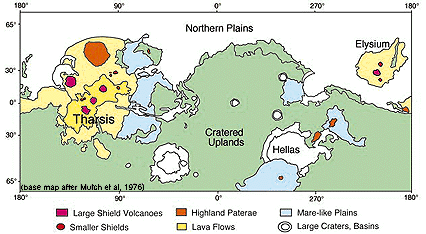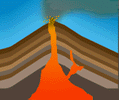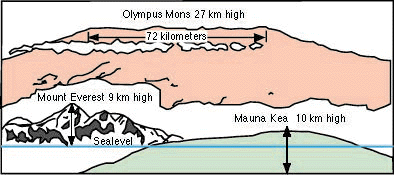Mars has one single Plate (no `tectonics'), but has two distinct terrains:
The Northern plains and the Southern Highlands. An enormous escarpment several
km high separates them. The Southern Highlands are rough and highly cratered,
being more than 3 billion years old. The North is much younger, with extensive
resurfacing, which happened about a billion years ago.
 Mars retained much of its internal heat, unlike the Moon or
Mercury, because it is larger. This
explains the occurrence of young surface regions.
The vast majority of volcanism occurs in the two regions, Elysium
and Tharsis. Martian volcanos are shield volcanos,
showing shallow slopes from tens of episodes of lava flow build up.
Mars retained much of its internal heat, unlike the Moon or
Mercury, because it is larger. This
explains the occurrence of young surface regions.
The vast majority of volcanism occurs in the two regions, Elysium
and Tharsis. Martian volcanos are shield volcanos,
showing shallow slopes from tens of episodes of lava flow build up.
 Tharsis is the greatest volcanic region, rising 8 - 9 km above
the rest and hosting Mars' greatest volcanos (Olympus Mons).
Tharsis is the greatest volcanic region, rising 8 - 9 km above
the rest and hosting Mars' greatest volcanos (Olympus Mons).
Why are the volcanos so large?
1) Lack of erosion (water or air), 2) No motion of
plates, 3) a long lived mantle hotspot. On Earth, plate
motion creates chains of smaller volcanos (Hawaiian Islands).
Mars' thicker crust helps support the large volcanos.
Volcanism has been extensive through out Mars' history, some
volcanos being several billion yrs old. Yet, it has also been
active more recently. Olympus Mons is thought to be less than
a billion yrs old. It's not known if
volcanism is presently still active or not.



 Tharsis is the greatest volcanic region, rising 8 - 9 km above
the rest and hosting Mars' greatest volcanos (Olympus Mons).
Tharsis is the greatest volcanic region, rising 8 - 9 km above
the rest and hosting Mars' greatest volcanos (Olympus Mons).